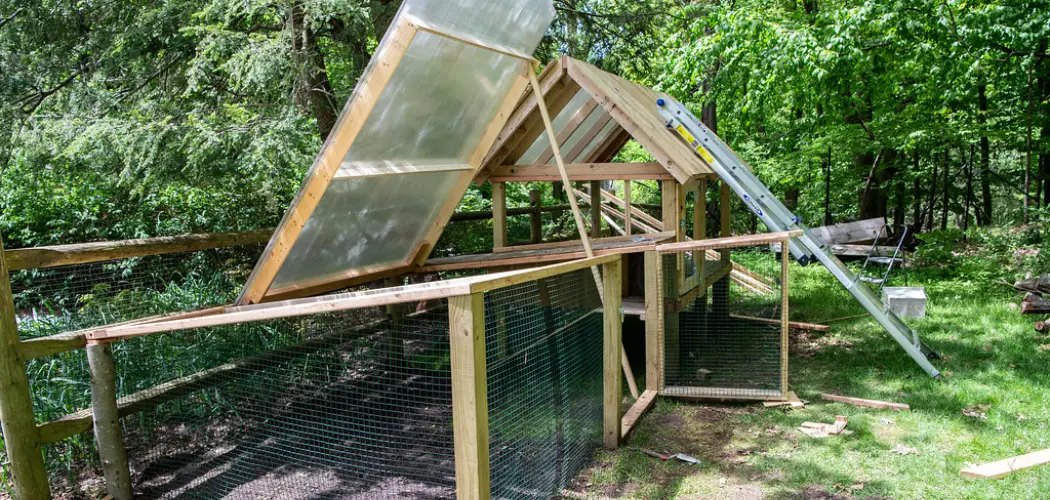Ensuring the well-being of your feathered flock is paramount, and one crucial aspect of their care is protecting them from the elements. When it comes to rainy weather, providing shelter for your chickens is essential to prevent stress, illness, and discomfort. Constructing a cover for your chicken run is a practical solution, shielding your poultry from rain and allowing them to roam comfortably in all weather conditions.
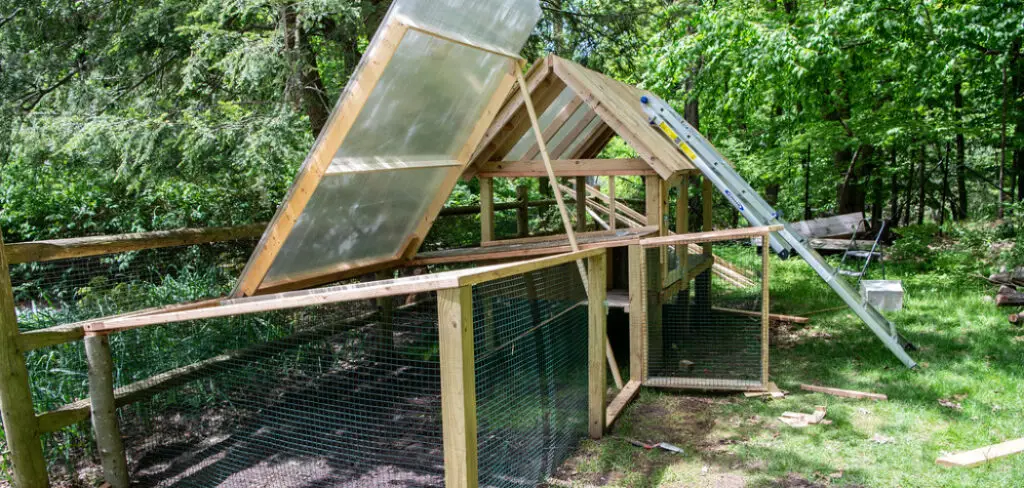
In this guide, we will explore various methods on how to cover a chicken run from rain effectively, considering both functionality and durability. Whether you opt for a simple tarp, corrugated roofing, or more elaborate structures, the goal is to create a dry and secure space for your chickens, promoting their health and happiness throughout the changing seasons.
The Importance of Providing Shelter for Chickens
Shelter for chickens serves as more than just a barrier against the rain; it’s a fundamental component of their overall living conditions that impacts their health and egg production. Exposure to wet conditions can lead to a range of health problems, including respiratory issues and the spread of parasites and disease.
A dry and protected environment is essential for maintaining the flock’s wellbeing and ensuring they continue to thrive. Moreover, a sheltered chicken run gives your birds the confidence to engage in natural behaviors, such as foraging and dust bathing, without the stress caused by inclement weather. Providing a reliable cover safeguards not only the physical health of your chickens but also their quality of life.
Benefits of Rainproof Coverage for Chicken Runs
Covering a chicken run from rain goes beyond keeping the space dry; it plays a pivotal role in the longevity of the structure and the health of the flock. Firstly, a well-constructed cover protects the chickens from harsh weather, reducing the risk of illness and discomfort.
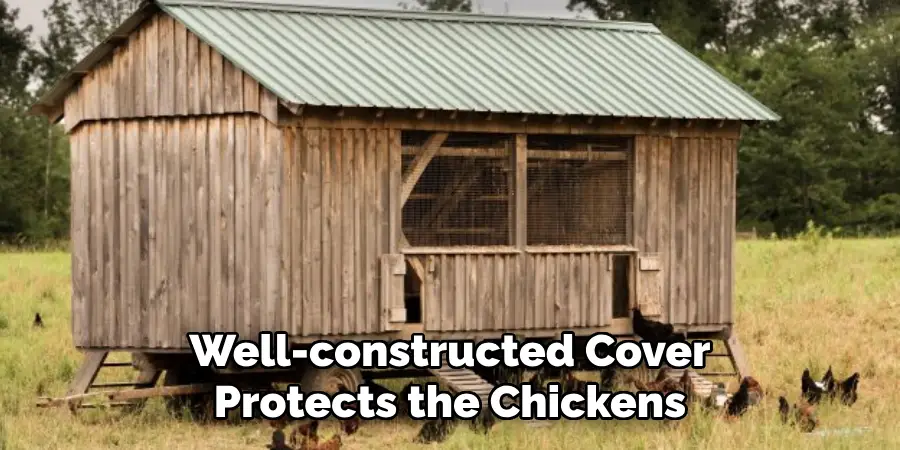
This is crucial for maintaining high egg production and the overall contentment of your birds. Additionally, a covered run protects feed and bedding from becoming wet, saving you from the repetitive costs and labor of replacing them after every downpour.
Not to mention, it prevents the ground from becoming muddy and unsanitary, which can harbor bacteria and parasites that are harmful to your chickens. Lastly, it adds an aesthetic appeal to your coop, potentially increasing the value of your property and the enjoyment of your serene, well-maintained backyard setting.
Assessing the Chicken Run
Before embarking on the construction of a cover, it’s imperative to assess your chicken run for size, structure, and exposure to the elements. Evaluate the area that needs coverage and consider how weather patterns affect that specific location.
Is it exposed to direct rainfall, or does it receive moisture primarily from windswept rain? The cover’s design must accommodate for both rainfall intensity and direction to be effective.
Additionally, inspect the chicken run’s framework to determine the most suitable materials and attachment methods for the cover. The existing structure must be sturdy enough to support the added weight of the cover, particularly when it’s laden with rainwater.
Every aspect from the slope of the roof to the durability of the materials should be carefully thought out to ensure that the cover can withstand the elements while also maintaining the health and safety of the chickens within.
Evaluating the Size and Layout of the Chicken Run
Before selecting materials and designing your rain cover, a thorough evaluation of the chicken run’s size and layout is essential. The dimensions of the run will dictate the amount of covering material needed, while the layout will influence the design of the rain cover. It’s important to measure accurately, taking into account both the length and width of the space, as well as the height of the enclosure to provide ample headroom for both the chickens and any caretakers attending to them.
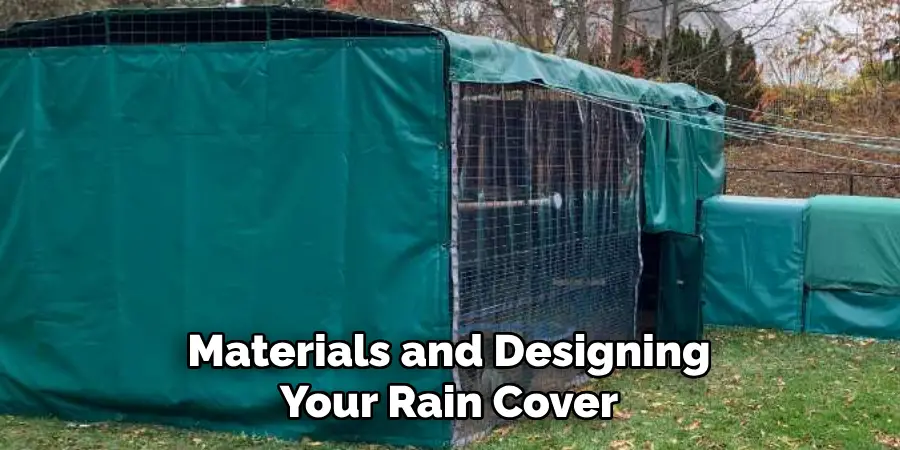
Furthermore, the arrangement of the run — including any existing features such as perches, nesting boxes, or vegetation — must be considered to ensure that the cover does not obstruct access or interfere with the natural behaviors of your chickens. The layout should also be contemplated for water runoff: a thoughtful design will direct rainwater away from the run to prevent pooling and potential flooding, contributing to a clean and dry environment for your flock.
Choosing Suitable Covering Materials
When it’s time to select materials for covering your chicken run, durability and weather-resistance are key factors to consider. Materials such as heavy-duty tarps, polycarbonate roofing panels, or metal roofing are popular choices due to their longevity and ability to repel water.
Heavy-duty tarps are cost-effective and easy to install; however, they may require more frequent replacement than more permanent solutions. Polycarbonate roofing is lightweight and lets natural light filter through, which can be beneficial for the chickens’ health and well-being.
Metal roofing, while more expensive, offers high durability and can withstand severe weather conditions over the years. It’s crucial to weigh the pros and cons of each material in relation to your climate, budget, and the specific needs of your chicken run before making a decision. Whichever material you choose, ensure it is securely fastened and provides adequate airflow to prevent excessive humidity inside the run.
10 Methods How To Cover a Chicken Run from Rain
1. Tarpaulin or Heavy-Duty Plastic Sheeting:
One of the simplest and cost-effective methods is to use a tarpaulin or heavy-duty plastic sheeting. Ensure it is UV-resistant and securely fasten it over the chicken run using ropes, bungee cords, or zip ties. Leave enough overhang on the sides to divert rainwater away from the run. Additionally, secure the edges of the tarpaulin to the ground using heavy rocks or bricks.
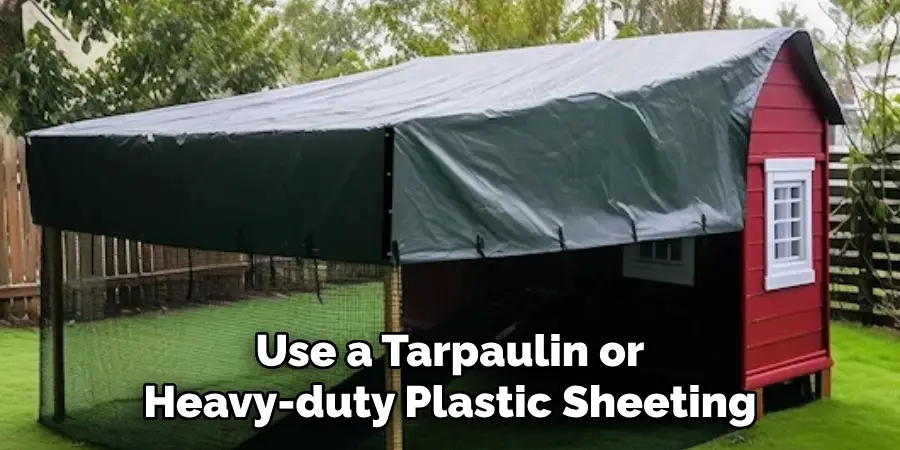
Another advantage of using a tarpaulin is that it can be easily removed and reattached for cleaning or maintenance purposes. However, make sure to regularly check and tighten any loose areas to prevent water from seeping in during heavy rains.
To further protect your chicken run from strong winds, you can also use wooden stakes or poles to reinforce the tarpaulin and keep it in place.
2. Corrugated Metal Roofing:
For a more durable and permanent solution, consider installing corrugated metal roofing panels. These panels are weather-resistant and provide excellent protection against rain. Install them with a slight slope to facilitate water runoff, preventing pooling and potential leaks. Additionally, corrugated metal roofing is lightweight and easy to install, making it a popular choice for DIY projects.
There are various types of corrugated metal roofing available in the market, including galvanized steel, aluminum, and copper. Galvanized steel is the most common option and offers great strength and durability at an affordable price. It also has a rust-resistant coating that helps to prolong its lifespan. On the other hand, aluminum is lightweight and corrosion-resistant, making it an ideal choice for coastal areas or places with high humidity.
Copper corrugated metal roofing is a more expensive option but offers unmatched durability and a unique aesthetic appeal. It naturally develops a beautiful patina over time, adding character and value to your home.
3. Polycarbonate Panels:
Polycarbonate panels are lightweight, durable, and allow natural light to penetrate the chicken run. Install these clear panels as a roofing solution, ensuring proper ventilation. They provide protection from rain while maintaining a well-lit environment for your chickens. These panels also act as a barrier between your chickens and predators, keeping them safe and secure.
Polycarbonate panels come in various configurations, including single-wall, double-wall, and triple-wall. Single-wall polycarbonate panels are the most affordable option but are not as insulating as other types. Double-wall polycarbonate panels have two layers of material with an air pocket in between, providing better insulation. Triple-wall polycarbonate panels have three layers, making them the most insulating and expensive option.

To ensure proper installation of polycarbonate panels, it is important to use aluminum profiles or U-channels that are specifically designed for these types of panels. These profiles will provide a secure fit and prevent any water leakage into the chicken run.
4. Shade Cloth:
Shade cloth not only protects chickens from rain but also offers shade during sunny days. Choose a high-density polyethylene (HDPE) shade cloth with UV resistance. Attach it securely to the chicken run frame, allowing for proper air circulation while keeping the enclosure dry. Additionally, shade cloth can also be used to protect plants in the chicken run from direct sun exposure and overheating.
Keeping chickens cool during hot weather is essential for their health and well-being. Shade cloth provides a simple and effective solution by reducing the temperature inside the chicken run. It also helps prevent heat stress, which can lead to serious health issues in chickens.
When selecting shade cloth for your chicken run, make sure to choose the right density and shade percentage. The higher the density, the more UV protection it offers. A shade percentage of 50-70% is ideal for providing enough shade without blocking too much light.
5. Netting or Wire Mesh with Overlapping Plastic Strips:
Create a rain-resistant barrier using netting or wire mesh with overlapping plastic strips. This method allows for adequate ventilation while preventing rain from directly entering the chicken run. Ensure the strips overlap enough to create a water-resistant barrier. This method is also useful in preventing predators from entering the chicken run.
Netting or wire mesh with overlapping plastic strips is a cost-effective and easy-to-install option for protecting your chickens from rain and predators. It can be used on both large and small chicken runs, making it a versatile solution for any size coop.
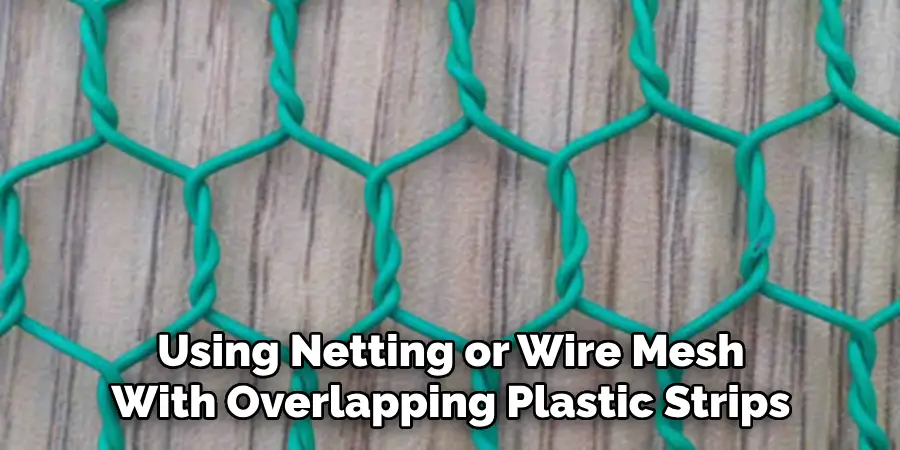
Additionally, this method allows for proper ventilation, which is essential for maintaining a healthy and comfortable environment for your flock. Adequate ventilation helps to regulate temperature and moisture levels, preventing issues such as mold and respiratory infections.
6. Sails or Canopies:
Sails or canopies provide a stylish and effective way to cover a chicken run. Install them above the run using poles or the existing structure. Opt for waterproof fabric materials to ensure reliable rain protection, and choose a design that complements your outdoor space.
Sails or canopies are not only functional, but they also add aesthetic appeal to your chicken run. They provide a stylish and effective way to cover the run while keeping your chickens safe from harsh elements such as rain, snow, and extreme heat.
When it comes to installing sails or canopies above your chicken run, you have two options: using poles or utilizing the existing structure. If you have a small chicken run, using poles is the most viable option. Simply secure the poles to the ground and attach the sails or canopies to them.
7. Wooden Shingles or Bamboo Mats:
For a natural and aesthetically pleasing solution, consider using wooden shingles or bamboo mats. Attach these materials securely to the chicken run frame, providing a rustic and effective rain cover. Ensure proper installation to prevent leaks and ensure longevity. These options also provide sufficient shade for your chickens during the hot summer months.
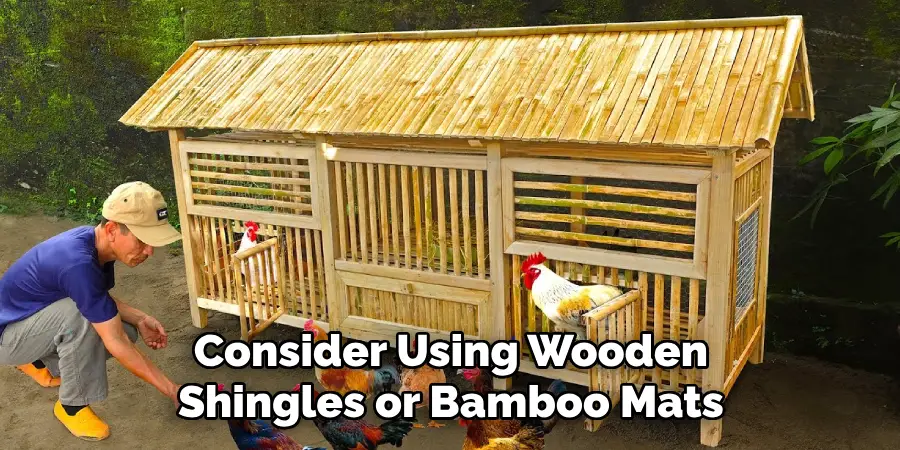
Wooden shingles and bamboo mats are sustainable options as they are biodegradable and can easily be replaced when necessary. They also blend in nicely with outdoor surroundings, making them a popular choice among chicken owners looking to maintain a natural look for their coop area. Additionally, these materials provide good ventilation and airflow, keeping your chickens cool and comfortable.
To install wooden shingles or bamboo mats, begin by measuring the dimensions of your chicken run. Then, cut the materials to fit and use nails or staples to secure them in place. Make sure to overlap the edges for better coverage and protection against rainwater.
8. Plexiglass or Acrylic Panels:
Plexiglass or acrylic panels offer a transparent roofing solution, allowing sunlight into the chicken run while protecting against rain. Install the panels with proper ventilation to prevent condensation. Ensure the panels are securely fastened to withstand wind and other weather conditions. However, it’s important to note that plexiglass or acrylic panels are not as durable as other roofing materials and may need more frequent replacements.
Other benefits of using plexiglass or acrylic panels include their lightweight nature, making them easier to install compared to other roofing materials. They are also available in a variety of colors, allowing you to choose one that complements your chicken coop design. Additionally, plexiglass or acrylic panels can be easily cut to fit any shape, making them versatile for different types of chicken runs.
When using plexiglass or acrylic panels as a roofing solution, it’s important to consider the thickness of the material. Thicker panels will provide better insulation and durability, but they may also be more expensive. Thinner panels, on the other hand, may be more affordable but won’t provide as much insulation and may need to be replaced more frequently.
9. Retractable Awnings:
Retractable awnings provide a versatile option, allowing you to adjust the coverage based on the weather. Install a retractable awning system above the chicken run, ensuring it is securely anchored. This method provides flexibility in managing rain protection.

Retractable awnings are available in different styles, sizes and materials. You can choose between manually operated or motorized systems. Manual operation requires a hand crank to extend or retract the awning, while motorized systems use an electric motor that is controlled by a switch or remote.
When selecting a retractable awning, make sure to consider the climate and weather conditions in your area. If you live in an area with high winds, be sure to choose a sturdy and wind-resistant material such as aluminum or heavy-duty fabric.
10. Green Roof or Living Roof:
Create a sustainable and eco-friendly rain cover by implementing a green roof or living roof on the chicken run. Plant low-maintenance vegetation on the roof, which not only provides natural rain protection but also contributes to the overall environmental well-being of the area. This type of roof also helps in reducing the heat island effect, air pollution, and energy costs.
In addition to providing natural rain protection and promoting environmental benefits, a green roof or living roof can also be used as an additional space for growing herbs or vegetables. The plants on the roof can act as filters for any chemicals or pollutants that may be present in rainwater, making it safer for the chickens to drink.
Conclusion
In conclusion, safeguarding your chickens from the challenges posed by rain is a fundamental aspect of responsible poultry care. The diverse methods explored for covering a chicken run offer flexibility to cater to individual preferences, budget constraints, and environmental considerations.
Whether opting for the simplicity of tarpaulins, the durability of corrugated metal roofing, or the aesthetics of green roofs, each method serves the common goal of providing a dry and secure space for your feathered companions. Thanks for reading, and we hope this has given you some inspiration on how to cover a chicken run from rain!
About
Outdoor Fixes is a distinguished figure in the world of Diy design, with a decade of expertise creating innovative and sustainable Diy solutions.
His professional focus lies in merging traditional craftsmanship with modern manufacturing techniques,
fostering designs that are both practical and environmentally conscious. As the author of diy,
outdoorfixes delves into the art and science of outdoorfixes-making, inspiring artisans and industry professionals alike.
Education RMIT University
(Melbourne, Australia) Associate Degree in Design (Outdoor Fixes) Focus on sustainable design, industry-driven projects,
and practical craftsmanship. Gained hands-on experience with traditional and digital manufacturing tools, such as CAD and CNC software.
Nottingham Trent University
(United Kingdom) Bachelor’s in outdoorfixes.com and Product Design (Honors) Specialized in product design with a focus on blending creativity with production
techniques. Participated in industry projects, working with companies like John Lewis and Vitsoe to gain real-world insights.
Publications and Impact
In diy, Outdoor Fixes his insights on indoor design processes, materials, and strategies for efficient production.
His writing bridges the gap between artisan knowledge and modern industry needs, making it a must-read for both budding designers and seasoned professionals.

